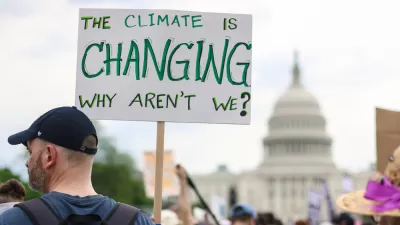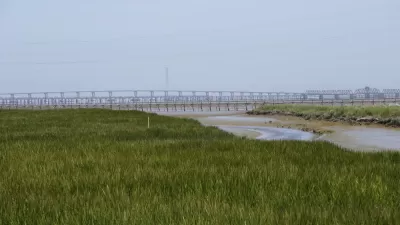The world’s coastal cities now face an impossible situation as a result of climate change. While the impacts and catastrophes become inevitable, why do cities like San Francisco dither rather than act?
Gabriel Metcalf makes an impassioned plea for more action on global climate change: “The international community has set a goal of limiting global warming to fewer than 4 degrees Fahrenheit. That is the current consensus of the upper limit to avoid catastrophic climate change. Achieving it would require the total cessation of emissions once we have spirited 800 gigatons of carbon out of the ground and into the air. By 2011, we were already two-thirds of the way to this threshold, and global emissions rates continue to increase.”
Metcalf also says it's possible to measure how successful humans have been in preventing the worst possible outcomes by how much fossil fuel we avoid using: “To keep warming below 4 degrees Fahrenheit, the International Energy Agency has found that we need to leave two-thirds of all known remaining reserves of coal, oil and gas in the ground, unburned.”
“There is a name for the new geological epoch we have entered: the Anthropocene, the era in which humans have caused profound changes to the outer layer of the earth,” writes Metcalf, who rather suggests a name for the era coined by author Kim Stanley: “The Dither.” The article then goes on to highlight some of the investments required in infrastructure to adapt to the inevitable consequences of climate change.
Of particular relevance to the planning and development process, Metcalf calls out the hypocrisy of those with environmentalist politics who nonetheless obstruct urban development: “[While] the Bay Area needs to channel all of its growth into walkable, transit-served locations, we still endlessly debate the merits of every individual building no matter how close to transit it is. If you believe that there is time urgency to cutting the American contribution to global climate change, the current system of endless process over action constitutes a moral failure.”
FULL STORY: The Great Dithering

Alabama: Trump Terminates Settlements for Black Communities Harmed By Raw Sewage
Trump deemed the landmark civil rights agreement “illegal DEI and environmental justice policy.”

Study: Maui’s Plan to Convert Vacation Rentals to Long-Term Housing Could Cause Nearly $1 Billion Economic Loss
The plan would reduce visitor accommodation by 25% resulting in 1,900 jobs lost.

Why Should We Subsidize Public Transportation?
Many public transit agencies face financial stress due to rising costs, declining fare revenue, and declining subsidies. Transit advocates must provide a strong business case for increasing public transit funding.

Paris Bike Boom Leads to Steep Drop in Air Pollution
The French city’s air quality has improved dramatically in the past 20 years, coinciding with a growth in cycling.

Why Housing Costs More to Build in California Than in Texas
Hard costs like labor and materials combined with ‘soft’ costs such as permitting make building in the San Francisco Bay Area almost three times as costly as in Texas cities.

San Diego County Sees a Rise in Urban Coyotes
San Diego County experiences a rise in urban coyotes, as sightings become prevalent throughout its urban neighbourhoods and surrounding areas.
Urban Design for Planners 1: Software Tools
This six-course series explores essential urban design concepts using open source software and equips planners with the tools they need to participate fully in the urban design process.
Planning for Universal Design
Learn the tools for implementing Universal Design in planning regulations.
Smith Gee Studio
Alamo Area Metropolitan Planning Organization
City of Santa Clarita
Institute for Housing and Urban Development Studies (IHS)
City of Grandview
Harvard GSD Executive Education
Toledo-Lucas County Plan Commissions
Salt Lake City
NYU Wagner Graduate School of Public Service





























